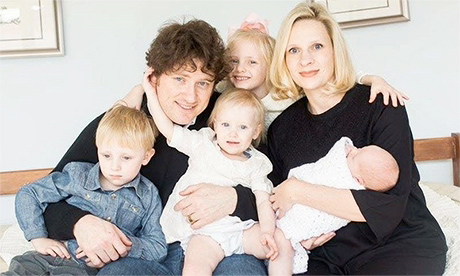My wife and I, we have four children, all younger than 7.
Ours is not a quiet house.
A house of screaming and a house of endless snot, it’s also a house of love, grown and multiplied every few years.
In a house of little sleep, my hobby these days is simply to sit down; fellow parents know what I mean.
Just like that loud and beautiful Kelly family gone viral out of South Korea recently, ours is a perfectly normal family, “normal” understood, of course, in relative terms. It’s both exhausting and energizing, and I wouldn’t trade it for anything.
It is the form and gift of my life, my family.
But here’s what’s strange about us: I’m a Catholic priest. And that is, as you probably know, mostly a celibate species.
Now the discipline of celibacy, as a Christian practice, is an ancient tradition.
Its origins belong to the very mists of early Christianity: to the deserts of Egyptian monasticism, the wilds of ancient Christian Syria and to Luke’s gospel.
You might be surprised to learn, most married Catholic priests are staunch advocates of clerical celibacy.
I, for one, don’t think the Church should change its discipline here.
In fact, I think it would be a very bad idea.
For priests, celibacy has been the universal legal norm in the Catholic West since the 12th century and the de facto norm long before that.
Saint Ambrose in the fourth century, for example, wrote about married priests, saying they were to be found only in “backwoods” churches, certainly not in the churches of Rome or Milan.
Yet there have always been, for good reasons, exceptions made, particularly for the sake of Christian unity.
The Eastern Catholic Churches, for example, many with married priests, have since early modernity flourished in the Catholic Church.
Likewise for me, a convert from Anglicanism.
I’m able to be a Catholic priest because of the Pastoral Provision of Saint John Paul II, which was established in the early 1980s.
This provision allows men like me, mostly converts from Anglicanism, to be ordained priests, yet only after receiving a dispensation from celibacy from the pope himself.
The Ordinariate of the Chair of Saint Peter in the United States, established by Pope Benedict XVI to provide a path for Anglican communities to become Roman Catholic, is another instance of the Church making an exception, allowing for the same dispensations from celibacy to be granted to priests.
But these are exceptions made, as I said, for the sake of Christian unity, because of Jesus’ final prayer that his disciples be “one.”
They do not signal a change in the Catholic Church’s ancient discipline of clerical celibacy.
Laity who have no real idea of what priesthood entails and even some priests who have no real idea of what married family life entails both assume normalizing married priesthood would bring about a new, better age for the Catholic Church.
Now you might be surprised to know most married Catholic priests are staunch advocates of clerical celibacy.
I, for one, don’t think the Church should change its discipline here. In fact, I think it would be a very bad idea.
Which brings me to my particular bête noire on the subject.
I get that I’m an ecclesiastical zoo exhibit.
On my way to celebrate Mass in Saint Peter’s in Rome a few years ago, fully vested in my priestly robes, I had to push my boy in the stroller through that ancient basilica as we made our way to the altar.
He had a broken leg, and Alli had the other kids to manage; and so there I was pushing the kid and the purse through Saint Peter’s, wide-eyed tourists’ mouths agape at the sight.
It is indeed quite a sight, a life outside the norm.
Even in my own parish, visitors will sometimes sheepishly step forward with curious and concerned questions.
“Are those your children?” they’ll ask in whispered tones as if it’s something scandalous, as my kids hide underneath my vestments as if it’s something normal.
A zoo exhibit as I said, but I’m happy talking about it, it’s not a problem.
It’s just us: Fr. Whitfield, Alli, and all the kids. A perfectly normal, perfectly modern, joyful Catholic family.
People’s assumptions frustrate
They are very few, of course, who refuse to accept me.
Hardened idiosyncratic traditionalists who think they know better than the tradition itself sometimes call it a heresy.
This, of course, is nonsense; to which, when such rare criticisms reach me, I always simply invite them to take it up with the pope.
He’s the one they should argue with, not me.
Most of the time, however, people see me as some sort of agent of change, the thin end of some wedge, some harbinger of a more enlightened, more modern church.
Being a married priest, they assume I’m in favour of opening the priesthood to married men, in favour too perhaps of all sorts of other changes and innovations.
This too is an assumption, and not a good one.
Laity who have no real idea of what priesthood entails and even some priests who have no real idea of what married family life entails both assume normalizing married priesthood would bring about a new, better age for the Catholic Church.
But it’s an assumption with little supporting evidence. Continue reading
Additional readingNews category: Analysis and Comment.




